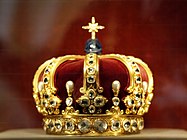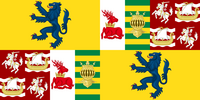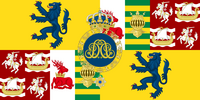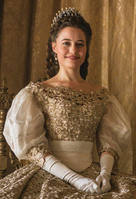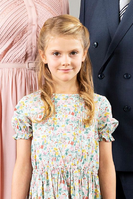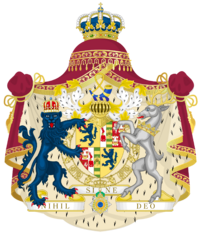Monarchy of Mascylla
This article is incomplete because it is pending further input from participants, or it is a work-in-progress by one author. Please comment on this article's talk page to share your input, comments and questions. Note: To contribute to this article, you may need to seek help from the author(s) of this page. |
| Queen of the Crowned Republic of Mascylla | |
|---|---|
| Königin der Gekrönten Republik Maskillien | |
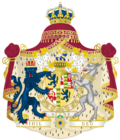 | |
| Incumbent | |
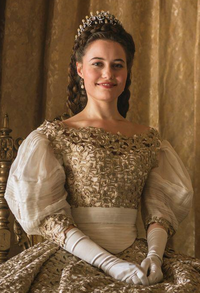 | |
| Dorothea I since 25 November 2005 | |
| Details | |
| Style | Her Majesty |
| Heir apparent | Prince Frederick |
| First monarch | Lukas I |
| Formation | 23 May 1793 |
| Residence | Königsreh Palace, Königsreh (official) Hohenehr Palace, Königsreh (private) Augusthal Palace, Augusthal (secondary) |
| Appointer | Hereditary |
| Royal family of the Crowned Republic of Mascylla |
|---|
 |
|
The monarchy of Mascylla, officially the Monarchy of the Crowned Republic of Mascylla (Hesurian: Monarchie der Gekrönten Republik Maskillien) and colloquially known as the Mascyllary monarchy (Hesurian: Maskillische Monarchie), is the monarchical and upmost constitutional institution of the Crowned Republic of Mascylla and its Overseas Territories. Current monarch and second historical queen is Dorothea I of the House of Ahnern-Welsbach since 25 November 2005, upon the death of her father, King Lukas III.
A constitutional monarchy in essence, it has ruled Mascylla since its inception in 1793, but after the Mascyllary Revolution in 1924 it has been transformed into a ceremonial monarchy under a parliamentary system. The Monarch is bestowed the title of King or Queen of Mascylla (Hesurian: König Maskilliens, Königin Maskilliens), among a variety of others. Upon the end of a monarch's reign, either by death or abdication, the successor is formally elected by secret ballot by a specially convened Convention of the Realm (Reichsversammlung); however, this style of elective monarchy has largely been of hereditary nature in practice, as the Crown Princes and Princesses of Ahnern have been elected without interruption since 1847.
The Queen and her close relatives execute a number of official, unofficial, representative and ceremonial duties and roles in Mascylla and abroad. While the Queen has the rights and powers of a constitutional monarch, she does not usually exercise them by herself due to the precedent of common law by her two predecessors, but instead relies on the Reichsrat, Reichssenat and Kronenrat for policymaking, therefore making her a de facto parliamentary monarch as opposed to her role granted by the royal prerogative that is stipulated in the Constitution. As the country's fount of honor, the monarch bestows honors and ceremonially appoints elected Prime Ministers, is able to secretly engage in discourse pertaining draft laws, and serves as the nominal commander-in-chief of the Mascyllary Reichswehr.
By the 19th century, Mascylla had developed into an united nation state following the War of the Five Kings and the peace negotiations of the Treaty of Langquaid that followed it. The historical rivalry between the monarchies of Aldia backed by the Elbgau Confederacy and Adwhin concluded with an Aldian victory, absorbing the remaining independent states and proclaiming their king, Lukas I, as Mascylla's monarch and effectively founding the Ahnern royal dynasty. The monarchies of each state within Mascylla were continued however, now under the supervision of the Aldian state. Over the next century, the monarchy ruled the Mascyllary Kingdom albeit with increasing authority and civil dissatisfaction. Culminating in the Mascyllary Revolution in 1923, the monarchy was dissolved at first and then radically reshaped, with the liberal Maximilian I as its figurehead. The fragmentation of the monarchy's powers enabled the foundation of a representative democracy as a parliamentary republic, which continues to rule Mascylla today. While the monarchy and its family is politically indecisive, they retain their cultural and symbolic significance as the country's traditional representatives while enjoying large public popularity.
Constitutional and official role
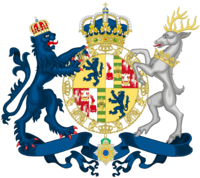 |
|---|
| This article is part of a series on the politics and government of Mascylla |
List
The Mascyllary monarchy is considered the continuation of the Aldian monarchy, but is not listed here.
| Name | Portrait | Birth | Marriages | Death | House |
|---|---|---|---|---|---|
| Lukas I Lukas Georg 23 May 1793 – 2 August 1827 (34 years) |
 |
16 July 1744 Augusthal Palace Son of Albert I and Anna of Geserheim-Soburg |
Princess Josephina of Welsbach-Sternau Augusthal Palace 13 November 1778 3 children |
2 August 1827 Hohenehr Palace Age: 83 years |
Lünburg |
| Lukas II Lukas Augustus 3 August 1827 – 28 October 1847 (20 years) |
 |
11 December 1780 Saarow House Son of Lukas I and Josephina of Welsbach-Sternau |
Sophia Martha of Marlburg-Gränich-Freida Hohenehr Palace 20 April 1800 5 children |
28 October 1850 Weidenau Palace Age: 69 years |
Ahnern |
| Sophia I Sophia Alexandra 2 November 1847 – 23 March 1882 (35 years) |
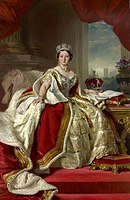 |
15 July 1810 Schönbrunn Palace Daughter of Friedrich Otto of Welsbach and Katharina of Ahnern-Mürbach-Konreid |
Albert of Lübbernau-Welbermark Marienfelde Residence 30 June 1829 4 children |
23 March 1886 Königsreh Palace Age: 76 years |
Ahnern-Welsbach |
| Friedrich I Friedrich Wilhelm 24 March 1882 – 5 September 1892 (10 years) |
 |
13 February 1831 Hohenehr Palace Son of Sophia I and Albert of Lübbernau-Welbermark |
Charlotte of Maining-Saanberg-Geisahl Augusthal Palace 8 May 1852 8 children |
5 September 1892 Heiligtann Palace Age: 61 years |
Ahnern-Welsbach |
| Ludwig I Ludwig Eduard Friedrich 6 September 1892 – 29 May 1923 (31 years) |
 |
31 January 1850 Böhrder Residence Son of Friedrich I and Charlotte of Maining-Saanberg-Geisahl |
Princess Alexandra of Tudonia Hohenehr Palace 12 April 1893 3 children |
29 May 1923 Königsreh Age: 73 years |
Ahnern-Welsbach |
| Mascyllary Revolution and establishment of the Crowned Republic in January 1924 | |||||
| Maximilian I Maximilian Karl Georg Albert 5 March 1924 – 14 June 1976 (52 years) |
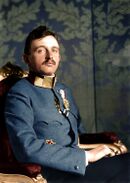 |
12 November 1914 Hohenehr Palace Son of Ludwig I and Alexandra of Shwesia |
Princess Sophia of Lavaria St. Lorenz Cathedral 22 March 1935 4 children |
28 June 2001 Schönbrunn Palace Age: 86 years |
Ahnern-Welsbach |
| Lukas III Lukas Albert Theodor Wilhelm 15 June 1976 – 24 November 2005 (29 years) |
 |
4 February 1938 Weidenau Palace Son of Maximilian I and Sophia of Lavaria |
Henriette of Taubach-Goldach and Birchau St. Lorenz Cathedral 11 September 1969 4 children |
Alive Age as of 2020: 82 years |
Ahnern-Welsbach |
| Dorothea I Dorothea Sophia Theresa 25 November 2005 – present (17 years as of 2022) |
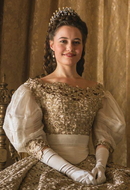 |
10 October 1987 Hohenehr Palace Daughter of Lukas III and Henriette of Taubach-Goldach and Birchau |
Wolfgang of Auserburg and Clemens Königsreh Palace 26 May 2005 3 children |
Alive Age as of 2022: 35 years |
Ahnern-Welsbach |
Family tree
Timeline

Cultural and symbolic significance
Titles
Symbols and arms
Orders and titles
| Styles of Queen Dorothea I of Mascylla | |
|---|---|
 | |
| Reference style | Her High Majesty (Ihre Hohe Majestät) |
| Spoken style | Your High Majesty (Eure Hohe Majestät) |
| Alternative style | Lady/Dame (Dame; in third person) Ma'am (Madame; in first person) |
The most commonly used titles and style of the monarch at present is as follows: "Dorothea the first, Queen of the Crowned Republic of Mascylla and of Her Other Territories in Overseas" ("Dorothea die erste, Königin der Gekrönten Republik Maskillien und Ihrer Anderen Territorien in Übersee").
However, in occasions of state visit reception or acts of national significance, as is the case in the appointment of a Prime Minister or the opening ceremony of the Parliament, the mid-sized style and title is used: "The Queen Dorothea the first of the Crowned Republic of Mascylla and Her Other Territories in Overseas, of Aldia Queen, of Fahnicht, Welsbach, and Birchau Grand Duchess, of Elpsland Sovereign and Supreme Duchess, of Jusland, Morleck, Nelgery, and Holnia Duchess, of Seebronn and Würthburg Burgravess, of Eustria Landgravess, of Falia, Lehpold, Lensrau, Geisahl, and Weibteich Princess, of Ahnern Countess" (Die Königin Dorothea die erste der Gekrönten Republik Maskillien, von Alden Königin, zu Fahnicht, Welsbach und Birchau Großherzogin, zu Elpsland souveräne und oberste Herzogin, zu Jusland, Morleck, Nelgern und Hohlnern Herzogin,zu Seebronn und Würthburg Burggräfin, zu Eystrun Landgräfin, zu Falien, Lehpold, Lensrau, Geisahl und Weibteich Fürstin, zu Ahnern Gräfin").
The correct etiquette to address the monarch in conversation is "Your High Majesty" (Eure hohe Majestät) and subsequently as "Ma'am" (Madame) or "Sir" (Herr). Additional styles include "By the Grace of God" (Von Gottes Gnaden) and "Margravess of Warthburg" (Markgräfin zu Warthburg), though these may be added or omitted upon the monarch's request. Moreover, ordinals are used for Mascyllary monarchs regardless of how peculiar or ordinary their name is, and the monarch is asked to choose a regnal name upon accession.
Regalia
The Mascyllary Crown Jewels (Maskillische Kronjuwelen) is the royal regalia and ensemble of ceremonial objects accessible to the Mascyllary monarch and held in trust, which are stored and on public display in Köpenick Palace (Schloss Köpenick). It consists of 74 items, including but not limited to: a complete set of coronation regalia with 2 sovereign crowns (St Theodore's Crown and Crown of Lukas I), 3 consort crowns, 5 princely coronets, 1 royal sceptre (Divine Sceptre), 5 swords (among them the Sword of the Crown), and 1 orb, 8 maces, 5 trumpets, 2 robes, 3 rings, and 1 pair of spurs.
Used for coronations of monarchs from the House of Ahnern, the crown jewels are an integral component to denote their role of head of state. During such ceremony, holy oil is used for anointment, the individual in question is invested with symbolic ornaments and robes, and subsequently crowned with St Theodore's Crown; after the 1793 formation of the Mascyllary Kingdom, the Kings of Aldia continued to use their regalia despite a new crown for Mascylla having been created and used once with Lukas I's coronation in 1793. The crown (Mascyllary State Crown, Maskillische Staatskrone) intended as their successor in 1924 was never created. However, a heraldic version of this crown exists. Queen consorts are invested with specially made crowns and regalia of plainer design.
Arms and standard
The monarch possesses the coat of arms of Mascylla as its sovereign, and is described as follows: "A Shield Or, halfed by a slim line with outbent Arms, and an Inescutcheon containing the Dynastic Arms of the Royal Houses. In the first Field three open Antlers Azure, placed over each other. In the second Field three Lions Azure, crowned with open Crowns Or. The Inescutcheon is party per pale the Arms for the House of Welsbach (Bendwise three Antlers Azure); and the House of Ahnern (Azure, three Lions watching over a Fortified Bridge Or and Argent)."
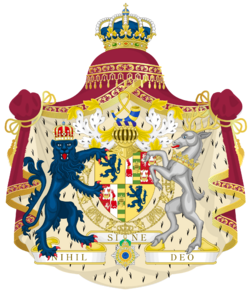
The royal standard, a personal flag of the differenced version of the coat of arms in banner form defaced with the monarch's royal cypher, is also used in their capacity as sovereign. Similarly to other special flags in use, it is flown only from buildings and vehicles when the monarch is present. The royal standard without a monarch's royal cypher is flown until a successor is elected.
When the monarch is not present at one of their residences, the ordinary Three Bands Flag of Mascylla is flown instead.
Residences
Royal family
Current principal royal family
Dorothea I, Queen of the Crowned Republic of Mascylla since 2005 (born 1987)
Wolfgang, Count of Auserburg and Clemens since 2005 (born 1984)
Frederick, Crown Prince of Ahnern (born 2006)
Julia, Princess of Mascylla (born 2007)
Victoria-Theresa, Princess of Mascylla (born 2012)


